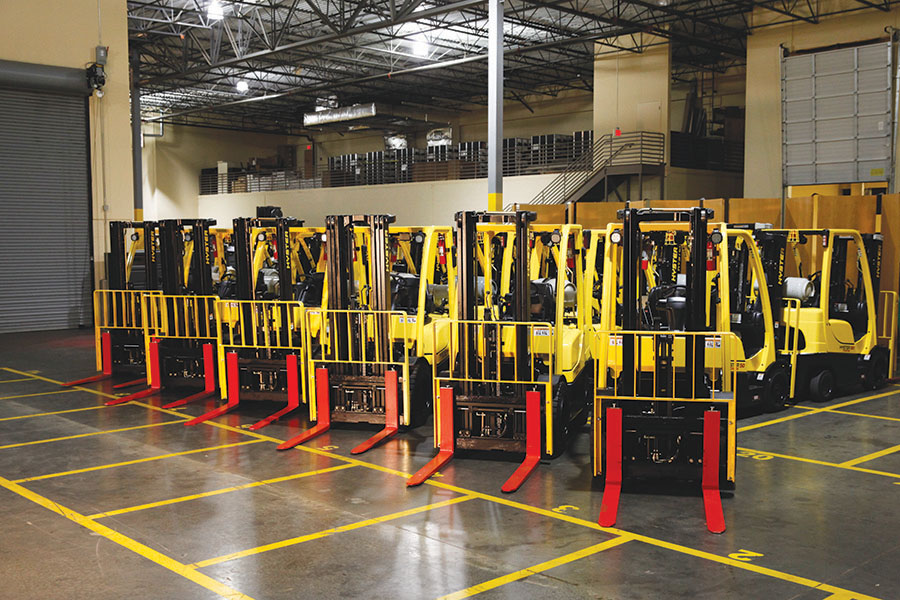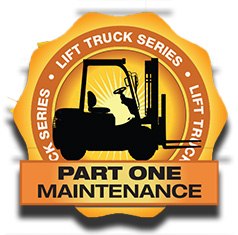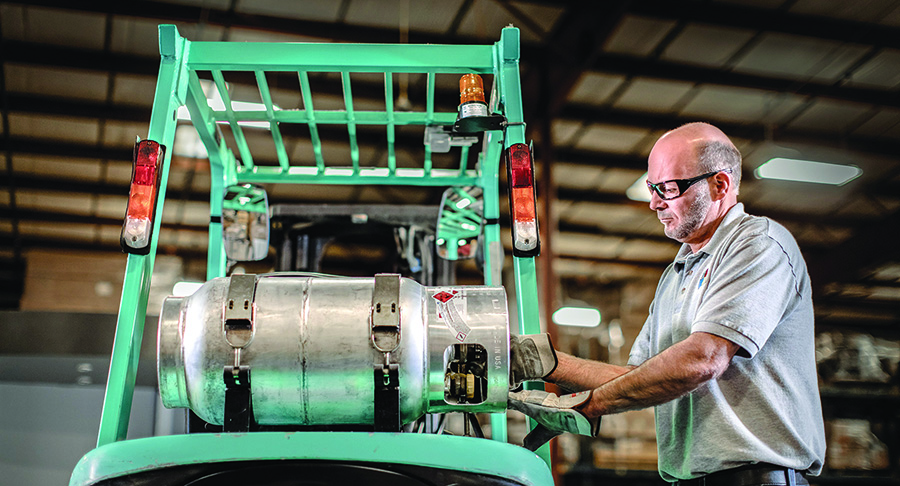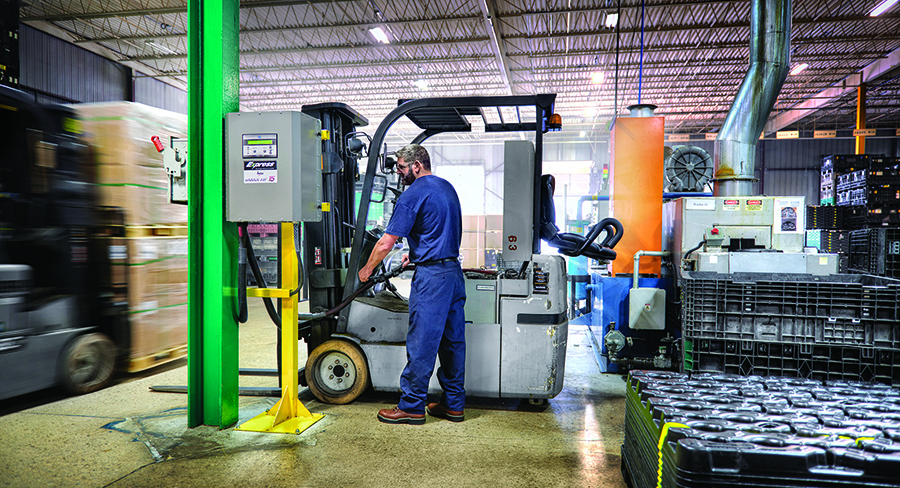Re-examining lift truck power structure
Although a fleet’s power source is often taken for granted, the benefits of adding, changing or replacing power sources can have far-reaching operational impacts.

 If, at any point, materials handling professionals find themselves saying “this is the way we’ve always done it,” then alarm bells should start ringing. Between technological advancement, labor shortages and competitive pressures, the companies that challenge their own assumptions are often richly rewarded.
If, at any point, materials handling professionals find themselves saying “this is the way we’ve always done it,” then alarm bells should start ringing. Between technological advancement, labor shortages and competitive pressures, the companies that challenge their own assumptions are often richly rewarded.
Data and visibility are exposing previously hidden opportunities for efficiency, and even less sophisticated operations can lean on equipment partners’ growing data analysis capabilities. One of the biggest blind spots is hiding in plain sight: the forklift fleet’s power source.
“In the literal sense, power is the most important aspect of any materials handling operation, as it drives fleet performance,” says Harold Vanasse, senior director of marketing of motive power for the Americas at EnerSys. “When it comes to overall operational improvement, knowledge is power.”
In the past, manually tracking data around battery productivity and performance was a tedious and often ineffective process. This made it difficult to manage an individual battery, much less to identify any broader fault in operations. As for internal combustion (IC) forklifts, telematics and data collection solutions have taken a bit longer to penetrate the market, according to Jeremy Wishart, director of off-road business development for the Propane Education and Research Council (PERC).
“Telematics have been part of the huge push for electric power and are partly responsible for the growth of the electric market,” says Wishart. “It wasn’t until recently that it became an accepted feature on an IC or propane lift truck.”
Analyzing fleet performance data can expose opportunities for process improvement, which is a great way to optimize the fleet and its operators. However, if these efforts are based around the assumption that the power source is set in stone, fleet managers could be missing even greater rewards. Comprehensive analysis can provide a more precise calculation of the benefits of transitioning from electric to IC or vice versa. It might even convince a reluctant manager to consider using more than one power source.
To help users uncover and pursue potential power options, Modern spoke with a propane expert, a battery expert and a fleet management expert. All agree that the landscape is dramatically different than a few years ago—and that the best is yet to come.
Looking under the hood
In the last 24 months, Steven LaFevers, vice president of emerging technology for Hyster, says motive power inquiries from current and prospective customers have been far above average. “They understand the technology curve has advanced dramatically in the last three years, and costs have changed,” he says. “They’re looking at options that didn’t exist five years ago.”
Still, LaFevers expressed surprise at how few customers understand available power options. The lack of awareness is partly a product of purchasing habits.
For the last 30 or 50 years, power conversations were solely with power companies,” says LaFevers. “A lead-acid battery company tends to talk about lead-acid and their power study will rarely point the customer elsewhere. It’s beneficial to deal with power-agnostic players that support all power sources.”
In addition to conventional lead-acid batteries, customers might evaluate virtually maintenance-free thin plate pure lead (TPPL) models, lithium-ion or hydrogen fuel cell alternatives. Generally, one-shift applications will find lead-acid is the best choice. For two-shift operations—if they can remember to plug in—LaFevers says TPPL or lithium-ion is often ideal. For three shifts, fuel cells are probably the best choice. But, there are always exceptions.
“When you think about managing power, the first step is to observe the pain points,” LaFevers says, listing common pains like the infrastructure cost for battery changes, protective equipment and safety risks, and under- and over-charging batteries. “Then it’s all about the effectiveness and availability of your charging habits. Pain points and charging habits are the two pillars of any thoughtful choice for power.”  Telematics are moving into the internal combustion space, addressing idle time and optimizing fuel usage.
Telematics are moving into the internal combustion space, addressing idle time and optimizing fuel usage.
Buying new batteries is only part of the solution. The customer is responsible for enforcing optimal charging habits, which is not as easy as it might seem. Forgetting to charge is a chronic and pervasive problem in most industries, and LaFevers sees many sites with forklifts parked at charging areas, but not plugged in. He describes a customer that was honest about their shortcomings in this area, but the application demanded consistent power availability. Even though they only run one shift, they went with lithium-ion because they were willing to pay a premium to address their pains.
“We use a lot of data to decide,” says LaFevers. “There’s a hypothesis that lithium-ion is a good solution for three-shift applications, and we found that’s true only if the operator has a more than 90% success rate at charging. That’s nearly impossible with distractions and leanness of the workforce. If they have a 10-minute break, they’re not going to spend five of that to charge.”
Power is all about productivity, LaFevers says, and given that labor strains impact any materials handling equipment today, productivity is top of mind. He says fuel cell products exist to challenge those pains, offering a three-minute refill and run time as long as nine hours. Compare this to six or seven hours for a new lead-acid battery, which will inevitably decrease over time.
“If an operator suddenly finds that they’re low on hydrogen, the impact is very brief, since it takes about three minutes to refill,” says LaFevers. “That’s not true with any other power source. Fuel cells, lithium-ion, and advanced lead acid batteries can be incredibly helpful to operator productivity.”
Leading the charge
Electric forklifts make up an estimated 65% of the North American market and 80% of the European market. As mentioned above, electrics in the post-recession era benefited greatly from the rapid development of telematics solutions. Despite a coinciding spike in battery costs over that time, technologies for monitoring battery and fleet performance helped users boost productivity and extend batteries’ lifespan enough to more than offset their initial price. Coupled with a favorable sustainability profile, electrics appealed to companies pursuing “green” initiatives.
The umbrella of “telematics” covers quite a large assortment of technologies, of which battery management is a subset. The success of the latest solutions is measured not by the quantity of data produced, but by how it targets a specific user’s pain points and provides actionable intelligence. Vanasse outlines a few general tiers of battery management programs.
“Deciding on the right program is dependent on the complexity of battery systems, the aggressiveness of operational goals and the level of involvement from the management team,” Vanasse says. “Customers now have the power to predict and reduce operational costs, and to improve and sustain productivity.”
Top tier programs generate reports to identify batteries that are underperforming or require repair, but they also help determine evolving battery needs to ensure users can meet current demands. Users can base every power-related decision on solid evidence and thorough analysis.
Vanasse says this streamlines budgeting for short- and long-term asset requirements, helps properly size battery and charger fleets based on actual usage, and accurately quantifies ROI for new technologies or operational changes.
Vanasse adds that a battery monitor is a foundational element, collecting granular, real-time readings of battery temperature, water level, discharge current, charge current, cell voltage balance and state of charge (SOC). Aside from more sophisticated battery management systems, he describes a computerized battery selection system and management report program. A relatively easy way to collect power data and make it actionable, this automated system—supported by reports and daily alerts—can help users right size their battery and charger fleet, significantly cut battery changing times and minimize capital and maintenance costs.  The right battery and charging technology can be transformative—but the benefits are limited without disciplined charging practices.
The right battery and charging technology can be transformative—but the benefits are limited without disciplined charging practices.
“Identifying the best batteries for shift changes can be a key first step to ensuring a battery fleet reaches its full lifecycle,” says Vanasse. The next step is battery-mounted monitors that users can periodically check manually, followed by the real-time monitoring for those who need more frequent updates. “The key difference between today and 10 years ago is the analytics that make selection and sizing decisions more accurately. This lowers costs and, perhaps more importantly, means the power source can dependably power their lift trucks.”
Igniting the debate
PERC’s Wishart says telematics solutions for propane and other IC forklifts took more time because manufacturers initially poured a lot into the development of next-generation electric forklifts, which was around the same time telematics broke onto the scene.
“As they got the electric models figured out, they were able to step back and re-engineer or update IC to make use of telematics,” says Wishart. “Specifically, the manufacturers who supply a lot of propane equipment like Toyota, MCFA, UniCarriers and Clark. I think they recognized an opportunity for the IC customers without telematics.”
Based on customer feedback, a lot of fleet managers are trying to significantly reduce idle time for IC equipment. Telematics solutions also help with speed management and route planning, and further enhance safety by tracking incidents and close calls. A strong focus is on the process of changing tanks.
“They want to change less often, and fleet managers are finding out there’s still a lot more fuel in the cylinder,” Wishart says. “If they were accustomed to just switching before every shift, now they’re changing based on telematics on an as-needed basis, instead of highly preventative and wasteful practices.”
The right approach should take larger factors into account. How much space is available? What are forklift operators capable of doing? Do they operate indoors, outdoors or both? What are the true environmental impacts?
“The general perception is that electric is the only ‘green’ solution, but that is now being questioned,” Wishart says. “The true emissions profile is becoming a hot topic for a lot of fleet managers and warehouse managers. We refer to that as the green/green issue. There’s emissions and the environment, then there’s green in terms of dollars staying with you or going out the door.”
Around the time of the recession, a lot of fleet managers were, if not complacent, then comfortable in terms of the equipment they were being supplied, whether electric or IC. Wishart says they stopped doing a lot of homework and accepted the new norm. “They became used to the higher-than-average IC fuel prices because that was part of economics worldwide,” he says. “Once they realized they had become comfortable and then looked at fuel prices and the cost of equipment again, they started to see that costs are coming back down.”
New propane engines are highly efficient, low-emission and cost-effective. Many forklift users are transitioning back to fuel from electric, and it’s now more common to see both used in a single facility.
“There’s still a fear of using more than one energy source, but we’re seeing that fear decrease,” Wishart says. “Some have four different power sources in the same facility. Managers want the right piece of equipment for the job, and that might call for multiple power sources. That will become the norm going forward as forklifts go higher, just-in-time inventory grows and everyone looks for faster cycles.”
Wishart acknowledges his bias toward propane, but also emphasizes that PERC’s education efforts are not just marketing. The goal is to present propane’s story with as much third-party data as possible, while advancing R&D efforts focusing on ultra-low and near-zero emissions.
PERC is working with partners to develop everything from waste heat management to hybridization to exhaust filtration technologies. The idea is to keep a finger on the pulse so PERC can shift as the market shifts.
“There’s an ‘electrify everything’ movement like we see on the West Coast, and I have nothing against electric, but it has to be about the economics, from the user up to the regulators and government as well,” adds Wishart. “To make a blanket approach to get everyone to go electric could be potentially damaging.”
Companies mentioned in this article:

Article Topics
Magazine Archive News & Resources
Latest in Materials Handling
Registration open for Pack Expo International 2024 Walmart chooses Swisslog AS/RS and software for third milk processing facility NetLogistik partners with Vuzix subsidiary Moviynt to offer mobility solutions for warehouses Materials Handling Robotics: The new world of heterogeneous robotic integration BSLBATT is looking for new distributors and resellers worldwide Lucas Watson appointed CSO for Körber’s Parcel Logistics business in North America Hyster recognizes Dealers of Distinction for 2023 More Materials HandlingAbout the Author
Subscribe to Materials Handling Magazine

Find out what the world's most innovative companies are doing to improve productivity in their plants and distribution centers.
Start your FREE subscription today.
April 2024 Modern Materials Handling

Latest Resources










